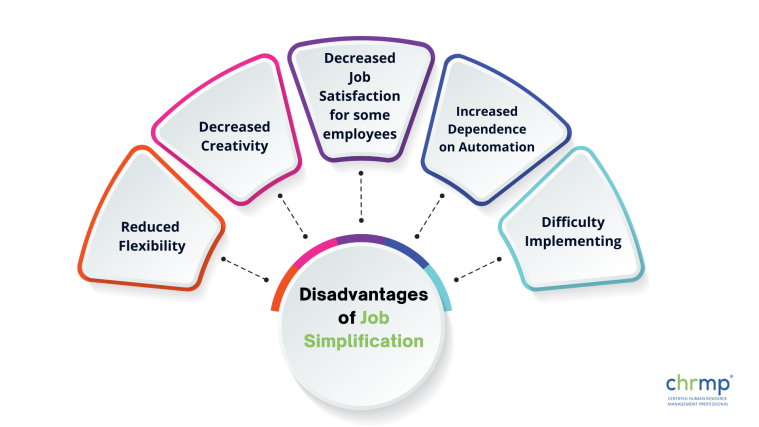

Are you tired of feeling overwhelmed at work? One always gets tired of feeling overwhelmed at work due to the endless tasks and responsibilities that bog you down. The solution to this problem is to simplify your job and take control of your workload. The “Job Simplification” concept is a 5-step process that helps us streamline our responsibilities and focus on what matters and what particular tasks are essential enough to be completed the same day on schedule.
Job simplification is a technique to streamline our responsibilities and focus on what’s important at work. It’s a process where our job is broken down into smaller, more manageable tasks, making our workload easier, more efficient, and less stressful.
Job simplification aims to identify areas where tasks can be consolidated, eliminated, or automated, resulting in a more straightforward, more focused job.
Let’s dive into the guide and learn how to simplify our job like a pro!
Job simplification is a process aimed at reducing the complexity and workload of a job, making it more accessible, more efficient, and less stressful. The job is broken down into smaller, more manageable tasks, eliminating redundant activities and automating repetitive processes. The goal of simplifying jobs is to create a focused, streamlined job that allows individuals to be more productive, efficient and have a better work-life balance.
The benefits of simplifying jobs can improve productivity, reduce stress levels, increase job satisfaction, and enhance overall work-life balance. It also allows individuals to focus on their strengths, leading to better job performance and career development. Simplifying jobs can lead to saving costs for organisations, as well as improved customer satisfaction and better overall outcomes.
Job simplification can be applied to administrative roles as well as to highly technical positions. It is a flexible and adaptable process that can be tailored to meet the specific needs of each job.
Job simplification is a valuable tool to help individuals take control of their workload and improve their work-life balance. By reducing complexity and streamlining responsibilities, job simplification has numerous benefits for individuals and organisations.
Simplifying jobs streamlines work responsibilities, reduces the number of tasks, eliminates redundant tasks and makes them easier to manage. This leads to increased efficiency and productivity, allowing individuals to complete more work in less time and, at the same time, achieve a work-life balance.

By simplifying jobs, individuals can focus on their strengths and avoid feeling overwhelmed by endless tasks and responsibilities. This can reduce stress levels and improve job satisfaction.
When jobs are simplified and broken down into smaller units, individuals are better able to focus on and perform to the best of their ability. This increases job satisfaction and gives a better overall work experience.
Simplifying jobs reduces the workload, allowing individuals more time for family, personal activities and pursuits. This leads to a better work-life balance and improved overall quality of life for the employees.
Simplifying jobs can increase efficiency and productivity, resulting in better cost savings for organisations. It improves customer satisfaction also and leads to better overall outcomes.
The 5-step process of job simplification is a systematic approach to streamlining work responsibilities and improving efficiency.

Below is a detailed break up of each step:
Analysis of the job is the first step to recognising the tasks and responsibilities involved. Identification of redundant or unnecessary activities, as well as which tasks can be automated or outsourced, is done at this step.
Prioritising the remaining tasks and responsibilities, focusing on the most essential and valuable activities to determine which tasks should be performed before and which ones later.
Elimination of redundancies and streamlining the remaining tasks to make them more manageable and efficient is done at this stage. This involves automating repetitive processes, delegating responsibilities and simplifying procedures.
Individuals are provided training and support to ensure they are comfortable with the changes and able to perform their jobs effectively.
The final step is to evaluate the results of the job simplification process. This helps to determine if the process is successful and also identifies areas for improvement. Continuous monitoring and improvement is essential to ensure that jobs remain relevantly streamlined over time.
By following this 5-step process, individuals and organisations can simplify their jobs, improve efficiency and productivity, and achieve a better work-life balance for their entire workforce. The approach is flexible and adaptable and can be tailored to meet the specific needs of each job in the organisational outfit.
While job simplification can bring many benefits, some potential disadvantages should be considered. Here are five potential drawbacks to job simplification:

By streamlining and simplifying jobs, the range of responsibilities and tasks may become limited and rigid, reducing overall flexibility, which makes it difficult for individuals to adapt to new challenges or changing circumstances.
Simplifying jobs can also lead to a reduction in creativity and problem-solving abilities. This is because individuals are less likely to be exposed to new and challenging tasks, which can limit their professional growth and development.
While job simplification and streamlining can improve job satisfaction for some individuals, for others, it may lead to decreased job satisfaction. This is because simplifying jobs can reduce the variety of responsibilities and make work less exciting and challenging.
Job simplification may involve automation to streamline processes. However, this can lead to increased dependence on technology and reduce the number of jobs available for human workers.
The process of job simplification can be complex and difficult to implement, especially in big organisations. Resistance to change and difficulties in getting buy-in from employees and stakeholders can surface.
In conclusion, while job simplification brings many benefits, it’s essential to consider the potential disadvantages and weigh the pros and cons before implementing the process. By understanding the potential drawbacks, individuals and organisations can make informed decisions and ensure that job simplification is implemented in a way that maximises the benefits, profits and minimises the risks and hazards.
When done correctly, job simplification can bring many benefits to an organisation in several key areas like employee productivity and morale, job satisfaction, reduces stress in the workplace, etc.
To help you implement a job simplification strategy in your organisation, here are five best practices you can follow to successfully implement your initiatives and create an efficient and streamlined work environment for your employees:

The first step in implementing a job simplification initiative in your organisation is to analyse the tasks that employees handle in their designated roles and look for areas that can be simplified. This may involve evaluating each task, step or process that fulfils the role and identifying any redundant or unnecessary steps and procedures that can be eliminated.
To identify redundancies in job tasks, employees are the best source. Employees who perform those tasks daily know the process like the back of their hand and can easily provide information on unnecessary steps.
You can involve employees in the job simplification process by collecting feedback, insights and suggestions, which will help you gain a firm understanding of the challenges faced by the employees in performing their tasks.
Once redundancies have been identified, it’s time to eliminate the unnecessary steps and processes. Simplify the workflow, and eliminate obsolete tasks, unnecessary paperwork or approvals.
The main focus should be reducing unnecessary tasks to make the job more efficient.
Once you implement the new changes, provide employees with orientation or training to help them get accustomed to the new processes.
Provide adequate information on the updated procedures, job aids, etc., and offer guidance and support as needed.
Once employees are properly accustomed to the upgraded workflow, monitor and evaluate the results of your initiative to ensure that they provide the desired changes.
You can do this by collecting employee feedback and keeping track of key performance indicators to measure how the changes impact productivity and efficiency levels.
Make further adjustments or changes as needed based on the results of the evaluation to ensure continuous improvement of your job simplification efforts.
Let’s look at some examples of job simplification in different types of workplaces to understand it better.
A company can simplify the process for customers to get in touch with the organisation’s customer service by implementing an online chat system or a self-service portal.
The sales process can be simplified by automating repetitive tasks and doing away with the redundancies, such as sending follow-up emails or tracking customer interactions.
Simplifying the human resources process by implementing an online system for tracking employee information and benefits, reducing the need for manual record-keeping.
Simplifying the inventory management process by implementing an automated system for tracking inventory levels, reducing the need for manual record-keeping, paperwork and reducing the risk of errors.
Simplifying the project management process by implementing project management software, which can automate task assignments, progress tracking, and communication between team members.
These are a few examples of how job simplification can be applied in different areas of an organisation. The key is to identify areas where processes can be streamlined, made more efficient, reduce redundant tasks and then implement changes to create an efficient impact.
What is the purpose of job simplification?
The purpose of job simplification is to make jobs more accessible and more efficient by reducing the number of tasks and responsibilities, streamlining processes, and improving overall job satisfaction.
Is job simplification applicable to all jobs?
Job simplification can be applied to many jobs, including administrative, customer service, sales, and management roles. However, depending on their nature and responsibilities, some jobs may not be well-suited to job simplification.
How does job simplification improve job satisfaction?
Job simplification improves job satisfaction by reducing complexity, allowing employees to focus on meaningful and important tasks, and freeing up time for rest and relaxation.
What are some of the key benefits of job simplification for organisations?
Some of the critical benefits of job simplification for organisations include improved efficiency, reduced costs, increased productivity, and improved employee morale.
What role does technology play in job simplification?
Technology can play an important role in job simplification by automating repetitive tasks, streamlining processes, and improving communication and collaboration between team members. However, it is vital to use technology wisely and ensure that it is not causing new problems or adding to job complexity.
In conclusion, job simplification is a crucial approach that can benefit both employees and organisations.
By breaking down complex tasks into more straightforward and more manageable steps, employees can experience reduced stress, increased job satisfaction, and improved performance.
Organisations can benefit from increased productivity, reduced errors, and streamlined processes.
However, it’s vital to approach job simplification carefully, considering the specific job requirements and employee needs, as oversimplifying tasks can result in adverse outcomes such as boredom, disengagement, and reduced creativity.
Therefore, finding the right balance between simplicity and complexity is critical.
Organisations can create a work environment that promotes efficiency, effectiveness, and employee well-being by implementing thoughtful and strategic job simplification techniques.
© 2007-2025 CHRMP| All Rights Reserved | Powered by Ripples Learning & Research Private Limited
